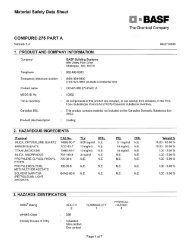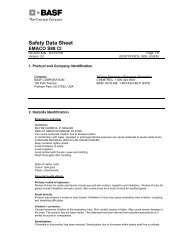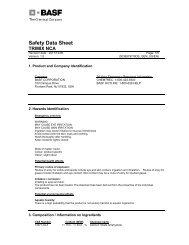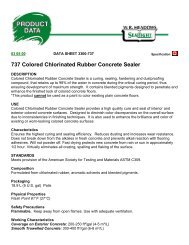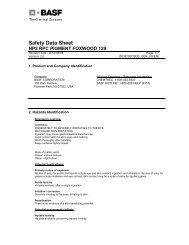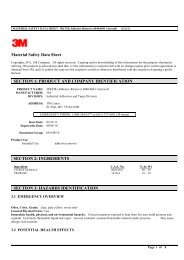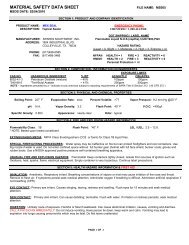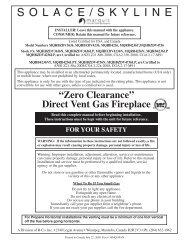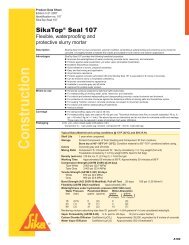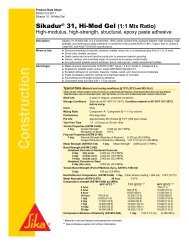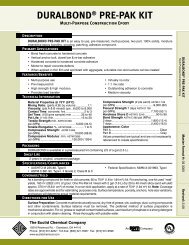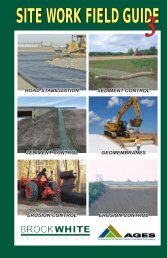MSDS - Insulation Supplies
MSDS - Insulation Supplies
MSDS - Insulation Supplies
Create successful ePaper yourself
Turn your PDF publications into a flip-book with our unique Google optimized e-Paper software.
Touch ‘n Seal® All Seasons Polyurethane Foam SealantTouch ‘n Seal Desert Formula Polyurethane Foam SealantRevision Date 01 Oct 2009Methods for ContainmentMethods for Cleaning UpOther InformationIf possible, turn leaking containers so that gas escapes rather than liquid. Allow substance toevaporate. Contain spilled materials if possible without risk. Absorb with materials such assawdust, dirt or vermiculite. Collect in suitable and properly labeled open containers. Do notplace in sealed containers. Curing foam gives off CO 2 . Wash what is left of the spill site withlarge quantities water.Attempt to neutralize the spilled material by adding suitable decontaminate solution:Formulation 1: Sodium carbonate 5-10%; liquid detergent 0.2 – 2%; water to make up to100%, OR Formulation 2: concentrated ammonia solution 3 – 8%; liquid detergent 0.2 – 2%;water to make up to 100%. If ammonia formulation is used, use good ventilation to preventvapor exposure. Sweep up and shovel into suitable containers for disposal.Ventilate the area. Curing foam gives off CO 2 . Do not put curing foam in a sealed drum.7. HANDLING AND STORAGEHandlingAvoid contact with skin, eyes and clothing. Wash thoroughly after handling. Ensure adequateventilation. Take necessary action to avoid static electricity discharge (which might causeignition of organic propellant vapors). Keep away from open flames, hot surfaces and sourcesof ignition. Do not Smoke. Avoid breathing vapors or mists. Contents under pressure. Do notpuncture or incinerate cans. Container, even those that have been emptied, can containvapors. Do not cut, drill, grind, weld or perform similar operations on or near empty containers.Do not stick pin or any other sharp object into opening on top of can.StorageKeep containers tightly closed in a cool, well-ventilated place. Keep in properly labeledcontainers. Keep in an area equipped with sprinklers. Keep out of the reach of children. Idealstorage temperature is 16-32 °C / 60 – 90 °F. Storage above 32 °C / 90 °F will reduce itsshelf-life. Never keep at temperatures above 48.8°C / 120°F.8. EXPOSURE CONTROLS / PERSONAL PROTECTIONExposure GuidelinesChemical Name ACGIH TLV OSHA PEL NIOSH IDLHMethylene bisphenyl isocyanateTWA: 0.005 ppmCeiling: 0.02 ppm75 mg/m 3(MDI)Ceiling: 0.2 mg/m 3Isobutane TWA: 1000 ppm N/A N/APropaneTWA: 2,500 ppmSTEL 1,000 ppm,3,500 mg/m 3 8Hr TWA: 1000 ppm1,800.0 mg/m 3 2100 ppmNIOSH IDLH: Immediately Dangerous to Life or HealthEngineering MeasuresPersonal Protective EquipmentEye/Face ProtectionSkin and Body protectionRespiratory ProtectionHygiene MeasuresShowersEyewash stationsVentilation systemsSafety glasses with side-shields.Impervious gloves. Lightweight protective clothing.Atmospheric levels of PMDI should be maintained below the exposure guidelines. If exposurelimits are exceeded or irritation is experienced, use a NIOSH/MSHA approved air-purifyingrespirator equipped with an organic vapor absorbent and a particle filter. For situations wherethe atmospheric levels exceed the level for which an air-purifying respirator is effective, use apositive-pressure air-supplied respirator. Respiratory protection must be provided inaccordance with current local regulations.When using, do not eat, drink or smoke. Maintain regular cleaning of equipment, work areaand clothing.Page 4



